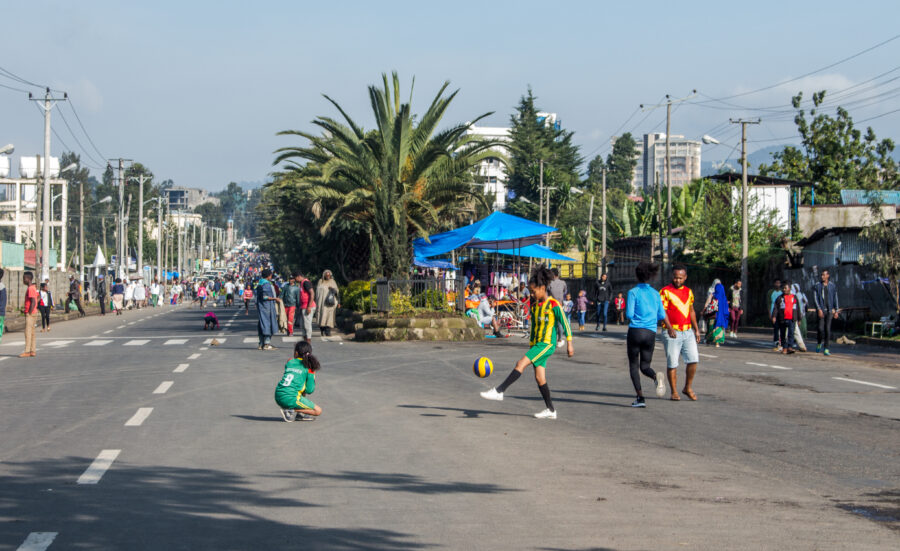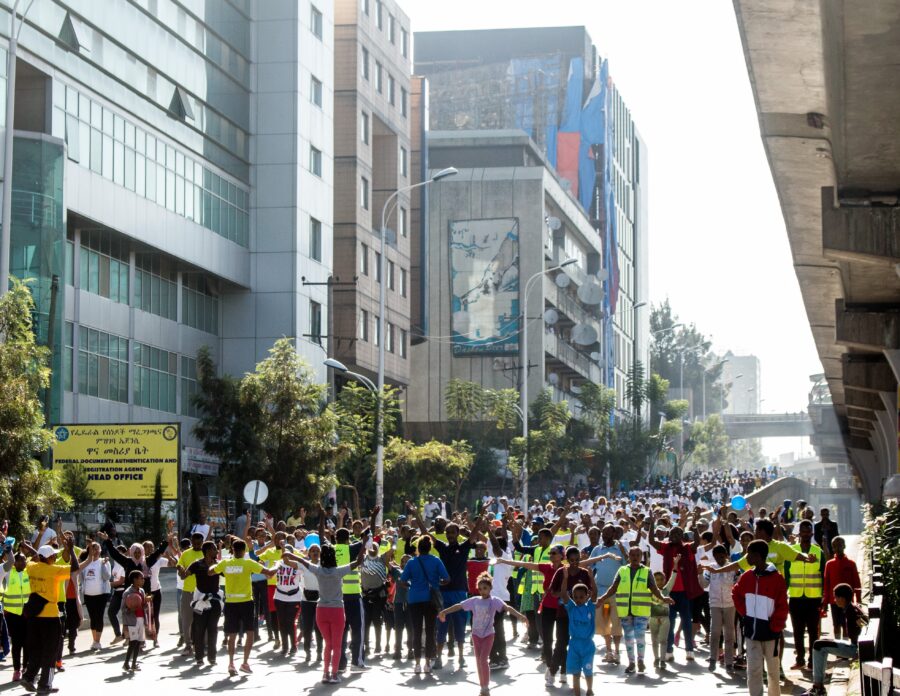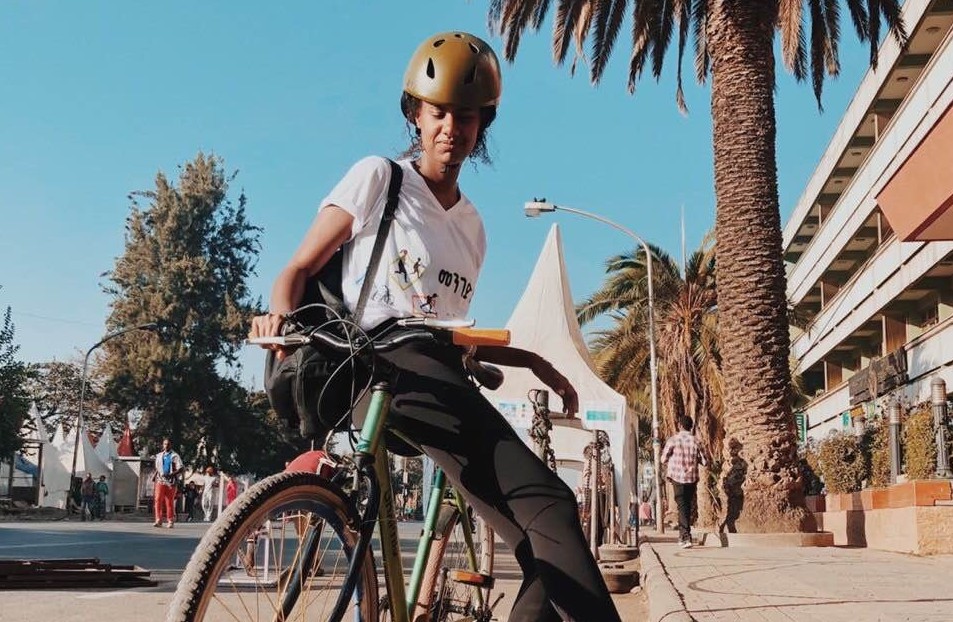10 min read.
Seble Samuel is an Ethiopian-Canadian geographer and storyteller. She works for the CGIAR Research Program on Climate Change, Agriculture and Food Security (CCAFS) in East Africa and is the co-founder of Ethiopia’s open streets movement Menged Le Sew. Seble was nominated in TUMI’s 2020 Remarkable Women in Transport.
How did Menged Le Sew get started and what were its founding intentions?
It was a mix of a few different things. I had lived for a few years in Latin America, where I first experienced the Ciclopaseo in Quito, Ecuador, and then a few years later, the Ciclovía in Bogotá. I moved back to Addis Ababa in 2016, where my family is from and alongside Muluken Nega, my co-founder, wanted to create something similar.
Even in the smallest Ethiopian cities, there’s a really big cycling culture. That just used to be how everyone moved around. There’s now an influx of rickshaws, that we call Bajaj, that are somewhat changing the landscape of urban mobility, but still active mobility dominates the streets. In smaller cities, it can go up to 90% of the modal share. In Addis Ababa however, even though people really dominate the street, that’s not what you see, in terms of how they are designed and occupied.
We began applying for grants and looking for examples on the continent. There weren’t that many and all roads were pointing to Open Streets Cape Town. So that’s how I got in touch with their co-founder Marcela Guerrero Casas and she was really great, sharing toolkits with information around budgets for example. This was essential as we didn’t know how to take the right steps for such a big grant proposal at that time.
In September 2018, we won the grant. Around the same period, in October, Open Streets Cape Town was organising an open streets exchange for African cities. I was accepted to go and there I met the head of the Traffic Management Agency of Addis Ababa, and a member of the Transport Programmes Management Office. It’s funny that we had to meet in South Africa, but we did, and when we returned we decided to make the event a reality for our city. We started meeting every single week and a collective of different people was formed. Muluken and I came from civil society, but there were all these different city offices such as Transport, Health, Youth and Sports, as well as organisations like the World Resources Institute.
From these meetings, Menged Le Sew was created. In December 2018, the former Minister of Health announced that there would be a national car free day, which brought our pilot event to a scale beyond what we were ready for. I think that we came in really strong on the third event, which was in February 2019. We used a decentralised model, following the logic that since the city is so big, we would have seven different locations. That meant that hopefully, wherever you lived, there would be one nearby. Altogether, it made up around 15 kilometres in the city. One of the locations got added just because the community started blocking the streets themselves, which is amazing. From there, it started spreading to other cities. The main intentions behind the project were safe streets because we have really high traffic fatalities and accidents. It was also a question of ecological sustainability, clean air and building stronger social connections. Cities are getting very economically and socially stratified, and it’s so important to have spaces for everyone, where active, healthy living can thrive.
Citizens have been engaged from the outset in shaping the events to meet the needs of the community, with involvement at all stages of planning, implementation, and review. How do you go about this citizen participation, and why do you think it’s important?
I think it helps from the onset that the organising collective is not just from one sector. That puts a lot of diverse agendas on the table, which I think is really important. Then we do a lot of community outreach and so much promotion. We would promote Menged Le Sew on around 17 different media houses of radio and TV. We put up thousands of flyers and posters, would hang banners in the city and tried to push hard on the community outreach. We invite organisations that share our vision to be in the space. For example, we’ve had SOS Addis, who has been campaigning for about a decade to ban plastic bags. We also worked with Noble Cup, who make reusable menstrual cups, and Hopeful River Project, who are doing river rehabilitation. We also invite the two big skate teams in the city, Megabi Skate and Ethiopia Skate. We also collaborated with Addis Air, a citizen science, air quality monitoring network. The idea here was to hang up air sensors in different event locations to compare air quality on car vs car free days.
These different groups bring their communities with them. Ultimately, it means that these diverse groups really shape the event and see themselves as part of it. For us, it makes it a lot more dynamic. It is also important because our causes are intersecting. It means so much more than blocking off streets, and it’s wonderful for us to have all these people in the same space.

By enabling a change in “how streets are perceived, invested, used and experienced”, open street events can bring about cohesive communities and more equitable streets. How do you see this in the future of Ethiopian cities?
Through Menged Le Sew we are actually showing people what that vision of streets can be. People are actually experiencing it together, they’re playing and enjoying being a part of the street. We really lack public space and especially green public space in the city and it’s interesting to see that children dominate these spaces during our events. I think it democratises our streets, they become a reflection of what happens when the majority is visible in public space. Normally, the majority is shunned to the fringes of inadequate pedestrian infrastructure for example. To be able to experience it and not just think about it as a concept is a really radical change. It makes it something that’s tangible and possible.
Of course, seeing it grow in new cities is amazing. We want the programming to increase in frequency and to have more connectivity between the sites because I think if you’re walking it’s fine but cycling for just a few kilometres is not that long. We also want it to impact city planning. There’s been some effects, for example through the creation of a 3km cycling corridor in one of the most popular locations of Menged Le Sew.
Around two years ago, Addis Ababa’s non motorised transport strategy came out, and then the national strategy was launched, unofficially on World Bicycle Day in June and then officially last month. There are huge targets to create more cycling and pedestrian infrastructure in the country: around 1000 kilometres of pedestrian infrastructure and 500 kilometres of cycling infrastructure within the next 10 years in the capital and also in secondary cities. Menged Le Sew’s open streets have really been embedded as part of the outreach strategy. This is an important sign that shows that it hasn’t just stopped at the programming, but that it has been taken into account by policy and planning. The core idea is that we should be able to move in our cities safely in a completely different way. This revives the culture around it, because it’s always existed, but it hasn’t been prioritised in terms of the space that we allocate in our cities. In our urban context, around 54% walk, and another 30% are taking public transit. It doesn’t make sense to be prioritising planning for 15% of the city that has a private car. If you make this idea tangible for people, they will demand it.
There’s also so much backing from the Ministry of Transport. Every time it scales to the national level, they’re the ones who are supporting it financially for example. They were going to do a national event in March but having thousands of people show up was not COVID friendly. As a response, since September the Ministry has been organising these monthly bike rides, somewhat on the principles of Menged le Sew but without programming and in a way that allows for social distancing. It’s promoting a culture of cycling. So I think there are a lot of outreach efforts to imagine this as not just temporary programming but as a fixed part of culture and infrastructure. It’s supposed to change our cities and I know that’s ambitious, but I think it has the capacity to do so in many cities around the world.

What were some challenges or hurdles that you encountered in the rollout of Menged Le Sew and how were you able to overcome them?
Communicating the intentions of Menged Le Sew was at first a challenge. Some public stakeholders tended to see open streets purely as recreation, and misunderstood its impact or gave it less priority. That was extremely limiting as Menged Le Sew is really about people reclaiming the streets, mobility justice, environmental sustainability, safe streets and healthy communities. That can rapidly become politicised and we weren’t used to it. We had to cancel multiple events just as we were beginning due to minor scheduling conflicts and general misunderstanding of our event from some key stakeholders for example. These types of issues stopped happening as much, because now Menged Le Sew is like the darling of the country, everyone loves it. Local institutions are always behind it and they’re really excited to promote it.
Secondly there were a number of physical challenges. There were issues of vehicles entering the open streets even though we had plenty of traffic management and volunteers. People didn’t really know the concept and in places with lots of feeder streets, it was hard to ensure that vehicles would not accidentally enter, even if we had barriers. Cars will do what they feel like. Once we figured out a better traffic management model we overcame this issue.
Lastly, I would say that we had to work hard to make sure that everyone who’s collaborating is really aware of our values. For example, we have people who want to distribute plastic water bottles, which is obviously good to keep people hydrated, but we’re trying to promote sustainability, so we can’t have plastic being generated from our programming. To maintain this coherence with our partners, we have to work to sensitise those we collaborate with or who take part. Muluken did really great work here, for example, through big training sessions for the traffic police. The open street was such a foreign concept to them. In the end, it’s simply a lot of coordination because there are so many different groups.
What would be your advice to other organisations seeking to start an open street event in their city?
You definitely need some sort of city partnership, it makes everything a lot smoother. I would say that’s a really big point. Public institutions are essential. Understanding how to block a street and redirect traffic, arranging for the other parts of the city to keep moving was something we hadn’t done before and where the city was very helpful and instrumental. You need to have these diverse collaborations, and you have to have a really diverse team. I’m so grateful for our team because we all have our skills and they do things that I have no clue how to do and vice versa.
Another learning relates to how we’re collaborating with all these organisations, for example, that I mentioned to you earlier. It’s a really great way to build something that’s more of a coalition. Bring in other organisations that are inspiring and that connect with what you’re doing.
Also, think beyond just programming. It should be thought of as more than a weekly or monthly event but as something long term. Really think about how it can impact the city. Here communication is key, from using all mediums to making your message as inclusive as possible, pushing this idea that everyone should be able to feel comfortable on the streets.
Lastly, try and create an experience that’s different from everyday city life. We want to show an alternative to this city. And then from that example, you see how that can become part of everyday life and not just something that happens once a month or a once in a blue moon. Amanda, from 880 Cities in Toronto, always says that for it to work you have to be obsessed with it. I think that’s probably true. And you need to have a few people on board who love the concept more than most, because it’s a lot of labour. But it feels so good. There are so many different things that you end up having to do and even if it feels really exhausting when you’re doing the organising, the second that it’s taking place, it feels so worth it. You are collectively building something you wouldn’t otherwise experience.

header photo by Girma Berta

